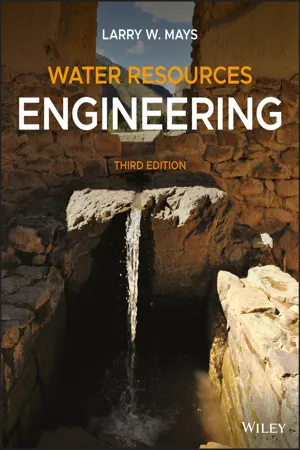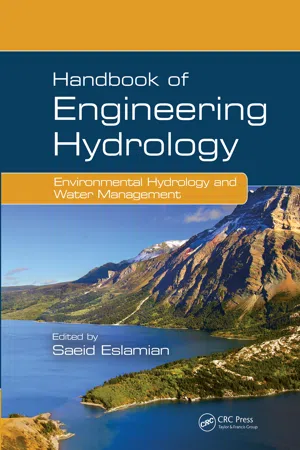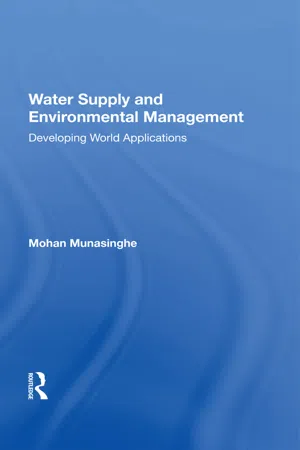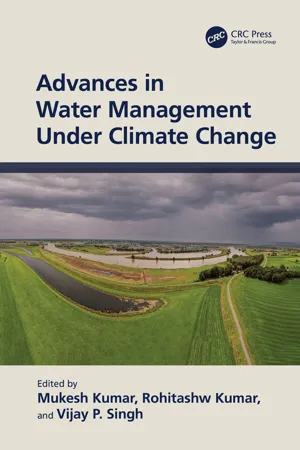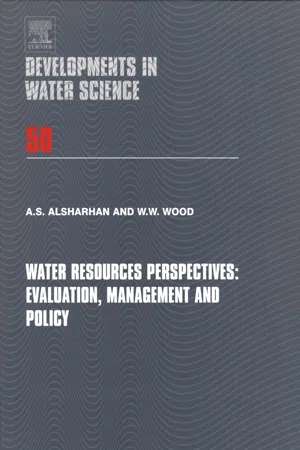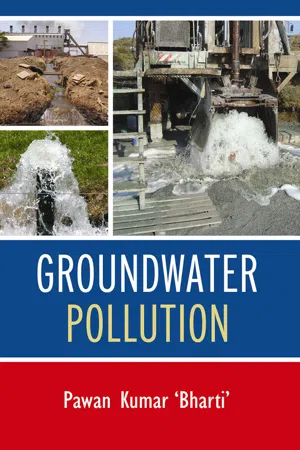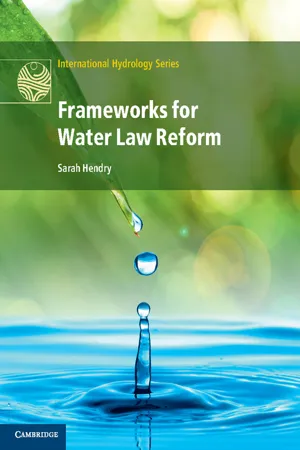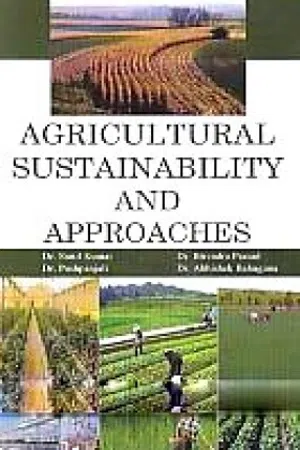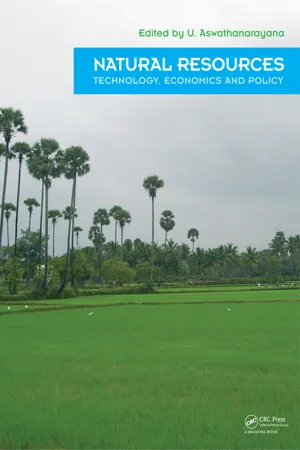Geography
Water Resources Management
Water resources management involves the sustainable and efficient utilization, protection, and allocation of water for various human and environmental needs. It encompasses the planning, development, and maintenance of water infrastructure, as well as the implementation of policies and regulations to ensure equitable access to clean water and the preservation of aquatic ecosystems. Effective water resources management is crucial for addressing water scarcity, pollution, and climate change impacts.
Written by Perlego with AI-assistance
Related key terms
1 of 5
11 Key excerpts on "Water Resources Management"
- eBook - PDF
- Larry W. Mays(Author)
- 2019(Publication Date)
- Wiley(Publisher)
Chapter 16 Water Resources Management for Sustainability In Chapter 2, a definition of water resources sustainability is provided along with examples of water resources unsustainability. The concept of sustainability explores the relationship among economic development, environmental quality, and social equity (Rogers et al., 2006). Then sustainable development consists of three components: economic, environmental, and social, also referred to as the triple bottom line. Many definitions, principles, criteria, and indicators have been reported (http:// www.sustainableliving.org). Based upon the many definitions and criteria, Rogers et al. (2006) define the following three caveats to evaluate each objective of the triple bottom line: • Economic objectives cannot be maximized without satisfying environmental and social constraints. • Environmental benefits cannot necessarily be maximized without satisfying economic and social constraints. • Social benefits cannot be maximized without satisfying economic and environmental constraints. There are many factors governing sustainable development of water resources. Key ones include poverty, pollution, population, and policy. The three determinants of sustainable development are consumption, production, and distribution (Rogers et al., 2006). This chapter explores Water Resources Management methodologies and tools for water resources sustainability. These include integrated Water Resources Management, water-based sustainable regional development, water law and policies, nonconventional methods and traditional knowledge, water resources systems analysis, and life cycle assessment (LCA). 16.1 INTEGRATED Water Resources Management FOR SUSTAINABILITY 16.1.1 Principles of Integrated Water Resources Management (IWRM) Integrated Water Resources Management is a key component in water resources sustainability. - eBook - PDF
Handbook of Engineering Hydrology
Environmental Hydrology and Water Management
- Saeid Eslamian(Author)
- 2014(Publication Date)
- CRC Press(Publisher)
In fact, an important and controversial key concept regarding the sustainability paradigm is how to align human activities with the environment in such a way that sustain-able development of resources would be achieved. To put this in practical use, understanding different changes in terms of the social, political, environmental, and economic landscapes is critical for effectively managing the current complex water resource systems. This calls for an integrated approach taking into account the interaction between physical and socioeco-nomic considerations. Integrated Water Resource Management (IWRM) provides a holistic framework for facilitating policy makers to successfully plan and mange water resources, as well as to gain insights into how the fragmented management of such resources can be prevented. This chapter aims to familiarize the readers with the sustainability approach in addition to categorizing the main school of thoughts for the term, providing the basic principles in IWRM, and representing the advanced methods applied for integrated water resource modeling. Integrated Water Resource Management and Sustainability 367 18.1.2 Need for Sustainable Water Resource Management In most cases, successful and effective water resource management is rare despite the numerous efforts, which have been made in order to fulfill this goal. This is primarily because water resource management is often fragmented and has suffered from a wide range of mismanagement practices, consequently threatening the sustainability of the water resources. - eBook - PDF
- Mohan Munasinghe(Author)
- 2019(Publication Date)
- Routledge(Publisher)
2 An Integrated Approach to Water Resource Management Water' Resoun:es Policy from a Natioaal Penpective Water is a fundamental requirement for almost all human activities. It plays a pervasive and critical role in every national economy. Because of the substantial investments required to accelerate the pace of water resource development, government involvement of some type becomes necessary. It is not surprising, therefore, that most developing countries are pursuing water supply programs, as part of their economic development efforts. This in tum implies that there are significant advantages to examining water issues in the context of overall national policy objectives, and therefore a multitude of other problems and constraints also have to be taken into consideration. In other words, it is important to recognize that water supply problems cannot be considered in isolation, but must be analyzed in relation to the general socioeconomic matrix within which they are imbedded, and the resources available. In view of the foregoing, water supply policy and planning should be developed within a framework that is: • Holistic -viewing water resources as an integral part of the national economy and natural resource base; • Realistic --based on the actual implementing capacity of the government, especially the managerial, skilled manpower, financial and physical resources available; and • Participative -with particular attention being paid to the design, implementation and monitoring of programs and projects, to ensure maximum involvement of beneficiaries and equitable distribution of benefits especially to low-income areas. An Integrated Approach 29 In most developing countries, it is clear that to achieve the greatest benefits, an integrated approach is required. - Mukesh Kumar, Rohitashw Kumar, Vijay P. Singh, Mukesh Kumar, Rohitashw Kumar, Vijay P. Singh(Authors)
- 2023(Publication Date)
- CRC Press(Publisher)
et al., 2013).1.3 CLASSIFICATION OF WATER RESOURCES
Available water resources are divided into two categories (Fig. 1.1 ):Long Description for Figure 1.1The process begins with three elements; Demand, Geophysical parameters, and water management. Demand leads to human and environmental water demand. Geophysical parameters lead to human and environmental water demand, water management systems, and water management options. Water management leads to water management options. Two-way arrows point between the Water management system and human environmental water demand, water management options, and evaluation criteria such as economic, management, and social. Also, two way arrows point between evaluation criteria and human environmental water demand and between evaluation criteria and water management options.FIGURE 1.1Conceptual diagram of water management (Parwal, 2015 ).- Surface water resources
- Ground water resources
1.3.1 Surface Water
Surface water is the naturally accessible water present on the Earth surface in the form of rivers, rivulets, streams, wetlands, and lakes. Water available from precipitation provides a considerable volume of water to available surface water, which is primarily used for commercial irrigation, farming, navigation purpose, and community water supply purposes. It may be divided into two types:- Lotic (flowing) water
- Lentic (still) water
1.3.2 Lotic Waters
The term lotic refers to flowing water sources, such as streams, ponds, runoff, and springs, and is derived from the word “lavo” which means “to wash”. Surface water bodies in the lotic region are mostly riverine and are dominated by advective movement. The fundamental goal of lotic water system is assumed to be conveyed surplus rainwater back to the oceans because the water in such system moves continuously. The lotic water system consists of ecosystems within them and is significant for a multitude of reason, including organic matter, nutrients, energy, and other compounds, absorbing constituents from the air and land transforming them, and/or transporting them to the sea.- eBook - ePub
- Roger A. Professor Sedjo, Roger A. Sedjo(Authors)
- 2010(Publication Date)
- Routledge(Publisher)
CHAPTER 5
Water Resources Management andthe Challenge of Sustainability
Leonard Shabman
WATER IS NEEDED to produce things people value, whether for manufacturing automobiles, growing lettuce and strawberries, ensuring greener lawns and full swimming pools, or for automated dishwashing to save time and improve household sanitation.1 And water provides for more than material comforts. In art, music, and literature, water in the landscape is a symbol of pleasure and inspiration. Water is the focus of even the least wild places—Japanese gardens and Las Vegas hotel fountains. Rivers, lakes, and reservoirs behind dams are at the center of many recreation experiences. To secure all these uses of water, significant public and private investments have been made to control and manage the flows of water in rivers and lakes and into estuaries. Dams create reservoirs that store rainfall and snowmelt from wet times to provide water during dry times. Pipelines and canals move water over long distances. Wells are drilled and water is pumped to the surface and used in homes and on farms.Water availability and the adequacy of the nation's water supply infrastructure to serve those many uses is a long standing national concern (Select Committee 1961;Wollman and Bonem 1971; U.S. WRC 1978; U.S. GAO 1982). Recently, Congress requested a review of “the future of water availability for the nation [because] water is vital to the needs of growing communities, agriculture, energy production, and critical ecosystems” (USGS 2002; Barlow et al. 2004). The Executive Office of the President (Subcommittee on Water Availability and Quality 2004) and the U.S. Department of the Interior (2005) recently issued reports on future water availability. A report from the National Research Council (2001c, v) concludes,In this new century, the United States will be challenged to provide sufficient quantities of high-quality water to its growing population. Water is a limiting resource for human well-being and social development, and projections of population growth as well as changing social values suggest that demands for this resource will increase significantly. These projections have fueled concerns among the public and water resources professionals alike about the adequacy of future water supplies, the sustainability and restoration of aquatic ecosystems, and the viability of our current water resource research programs and our institutional and physical water resource infrastructures. - W.W. Wood, A.S. Alsharhan(Authors)
- 2003(Publication Date)
- Elsevier Science(Publisher)
Water Resources Management AND POLICY This Page Intentionally Left Blank Integrated Water Resources Management is more a Political than a Technical Challenge JOHN ANTHONY ALLAN SOAS/King's College London Water Research Group, SOAS, Thornhaugh Street, London WC1H OXG, UK. Email [email protected] ABSTRACT: The Integrated Water Resource Management (IWRM) approach was developed by environmental scientists, water resource engineers and economists in the late 1980' s and the 1990' s. Integrated Water Resource Management was a response by water resource planners to the negative outcomes of past water resource policies. Past practice did not for example properly recognise that sectoral demands could be competitive. The conflict between irrigated agriculture and the environmental services provided by water is a classic case. Upstream and downstream uses can also be incompatible. Integrated Water Resource Management was supposed to address these potential contests by planning. The study will show first, that Integrated Water Resource Management is a discursive political process and not just a planning process. Secondly it will show how social and political theory can be used to explain how and why attitudes to water resource allocation and management have changed through the last half of the twentieth century. Thirdly, such theory will also be used to show why the assumptions of Northern water policy makers and politicians differ from those in the South on how to achieve 'sustainability'. The analysis will focus on the last three decades of the twentieth century when green social movements had a decisive impact on the way environmental services were perceived. Finally, the study will argue that the pace of adoption of water policy reform has been very much slowed in the Middle East in particular through the import of 'virtual water' to ameliorate the region's serious water deficit. Virtual water is the water embedded in water intensive commodities such as wheat.- eBook - PDF
- Bharti, Pawan Kumar(Authors)
- 2021(Publication Date)
- Biotech(Publisher)
At the national level, especially in water scare-regions with dense population, adopting a watershed or river basin management perspective or harvesting of rainwater is required as an alternative to uncoordinated water-management policies. At the international level, countries that share river basins can design workable policies to manage water resources more equitably. Ancient techniques of water harvesting, like digging of deep underground chambers for storing rainwater from the wet season for use during the dry season, or placing of long lines of stones along the contours of gently sloping ground to slow runoff and spread the water across a wider area, are prevalent This ebook is exclusively for this university only. Cannot be resold/distributed. in some societies. These practices when applied together have been known to increase crop production by as much as 50%. Treated urban wastewater from towns and cities, often referred to as ‘brown water’, may be channeled onto nearby farms for growing vegetables and fruits. In Calcutta, much of the raw sewage is channeled into a system of natural lagoons, where fish are raised. The city’s hectares of lagoons produce about 6,000 metric tons of fish a year for urban consumers. However, there is a need to be cautions as unless urban wastewater receives some pre-treatment, either from natural wetlands or sewage treatment plants, it can transfer disease organisms to vegetables and fruits or fish and endanger human health. Watershed management, which refers to managing an entire land area served by all the rivers and aquifers that drain into a particular body of water, such as a semi-enclosed bay, has assumed great importance as a water conservation measure. A river or a lake must be seen along with its entire watershed and all its physical, chemical, and biological elements, as part of a complex, integrated system. People living in most of these watersheds have radically altered the natural drainage systems around them. - eBook - PDF
- Sarah Hendry(Author)
- 2014(Publication Date)
- Cambridge University Press(Publisher)
As noted above, the definition of water resources in the NWA includes surface waters, groundwater and also wetlands, though it does not extend to coastal waters. Overall the NWA has provided a structure for water resource management that enabled a very proactive and water-focused reform agenda to be carried out in a challenging economic and social environment, but one in which there was a high incidence of political will. Currently the NWA works with the Water Services Act (WSA), 175 though there is a proposal from the Department of Water Affairs (DWA), also discussed in the second NWRS (NWRS2), to merge the two Acts into one complete legislative framework, along with certain other legisla- tive and policy reforms. 176 South African experience in IWRM and the associated operational areas of water quantity and quality management provide many excellent examples of the iterative nature of the IWRM process, the way that process can develop over time, and the hurdles and difficulties encountered. The purpose of the Act is stated as being to ‘ensure that the nation’s water resources are protected, used, developed, con- served, managed and controlled in ways which take [the following] into account . . .’ 177 There follows a list of non- exhaustive factors, including the basic human needs of present and future generations, equitable access, redressing past discrim- ination and ‘efficient, sustainable and beneficial use’. These factors are not stated to be in priority order, but the NWA also lists the provision to be made by the NWRS, beginning with the Reserve, then international obligations, and then other water needs. 178 The first NWRS considered that this was an order of priority. 179 The NWRS2 is more focused on the general principle of equitable reallocation, within which basic human needs are a starting point, and de facto prioritised, but only a starting point. - eBook - PDF
- Kumar, Sunil(Authors)
- 2021(Publication Date)
- Biotech(Publisher)
Chapter 11 Water Resources and Management Mukesh Kumar 1 , Manish Kumar 2 , Teena Rani 3 , Manoj Khanna1 and J.C. Dagar 4 1 Indian Agricultural Research Institute, New Delhi 2 Animal Husbandry and Dairying, Government of Haryana 3 CCS HAU, Hisar, Haryana 4 ICAR, Krishi Anusandhan, Bhawan II, Pusa, New Delhi Introduction Water is the most precious gifts of the nature to mankind; the terrestrial ecosystem cannot function without it. All life and peripheral activities are ceased without water. Water sustains aquatic biodiversity, economic development and ecological integrity of environment. We use renewable freshwater for drinking, irrigating the crops, and industrial uses, transportation, recreation and waste disposal. Water is a powerful indicator of ecological sustainability and economic prosperity (Anonymous 2002, Singh et al ., 2006). The 70 per cent of the earths’ surface is covered with water but in reality 97.3 per cent of total water on the earth is saline and only 2.7 per cent is available as fresh water ( Figure 11.1 ). About 77 per cent of this fresh water is locked up in glaciers and permanent snow and 11 per cent is considered to occur at depths exceeding 800 m below the ground, which cannot be extracted with the technology available today (CGWB 2007). About 11 per cent of the resources are available as extractable groundwater within 800 m depth and about 1 per cent is available as surface water in lakes, reservoir and river systems. On the basis of the available water resources, the total irrigation potential from surface and groundwater resources is estimated to be 140 Mha that could be further enhanced by an This ebook is exclusively for this university only. Cannot be resold/distributed. additional 35 Mha after the inter-linking of rivers materializes (Singh 1999, Singh 2002). The global renewable water supply is about 7000 m 3 per person per year. - eBook - PDF
Water Policy
Allocation and management in practice
- P. Howsam, R.C. Carter, P. Howsam, R.C. Carter(Authors)
- 1996(Publication Date)
- CRC Press(Publisher)
As pollution control, together with recycling and desalination, cannot offer inexpen-sive and rapid options, and development of groundwater and natural flows are limited, one of the few option is to develop surface water storage. Improved cropping management, including production-effective and high tolerance crops, and the use of water of marginal quality, also have a lot of promise. Policies to mitigate shortage o ffunding The major concern is that while only short-term, and often insufficient, funding is being allocated and made available to the water sector, the very large financial needs in the next decades have not even been analysed and prioritized. Privatisation, which is often being promoted, remains dependent on the traditional source of funds - Government or beneficiaries - and has proven to be an uncertain source of financing, especially under conditions of water scarcity and economic recession. In contrast, increased service fees and transfers of financial responsibilities to beneficiaries represents an efficient and timely option for improving funding, with -- Management in national water scarcity 67 major longer-term retrenchment of financial responsibilities from Government. It is consistent with, and goes in parallel with, the slower process of removal of subsidies in the water sector. 7 Conclusions With changing social and economic conditions and weak governance in developing countries, what are considered normal conditions for water resources and the capacity to manage water scarcity can be expected to change drastically in the next decades. Current conceptions and approaches to managing water scarcity focus on use of water where it is available, and re-allocation of available water for its greatest benefits. - U. Aswathanarayana(Author)
- 2012(Publication Date)
- CRC Press(Publisher)
The objective of the water production process is to collect and store water having the required utility properties (quantity, quality, place and time) which may be required for final consumption (e.g. water for domestic use, irrigation water) or a means of production (e.g. water for transportation, water for power production). Water is thus an economic good. But unlike other economic goods like coal and oil, water cannot be treated in purely economic terms, since human life itself depends upon it. Water resources are sought to be protected and augmented by providing for well-head protection, protection around water springs, and wastew-ater reuse. The efficient use of water involves, among other things, the reduction in conveyance losses, and minimization of evaporation. 2.5.7.1 Water reservoirs There may be many reasons for building water reservoirs, such as: – Providing water for domestic purposes (potable water), industry (utility water), and agriculture (irrigation), – Flood control, – Power production, – Inland water transport, – Recreation, etc. Water Resources Management 99 The construction of a reservoir perturbs the natural environment and affects the geo-graphical, climatic and social conditions. There may be beneficial impacts on the economy and way of life of the people through the development of new economic activities (agriculture, power production, inland transport, recreation, etc.). There may be adverse effects on the health and productivity of men and animals (e.g. inci-dence of waterborne diseases, schistosomiasis, etc.), and there is the potential danger arising from the failure of the dam due to torrential rains or an earthquake. Reservoirs affect the following components of the biophysical environment (Holy, 1982, p. 73): – Solar radiation and the thermal balance of the accumulated water, – Temperature of the air, and fog formation, – Air currents (similar to those near the sea), and – Air humidity.
Index pages curate the most relevant extracts from our library of academic textbooks. They’ve been created using an in-house natural language model (NLM), each adding context and meaning to key research topics.
